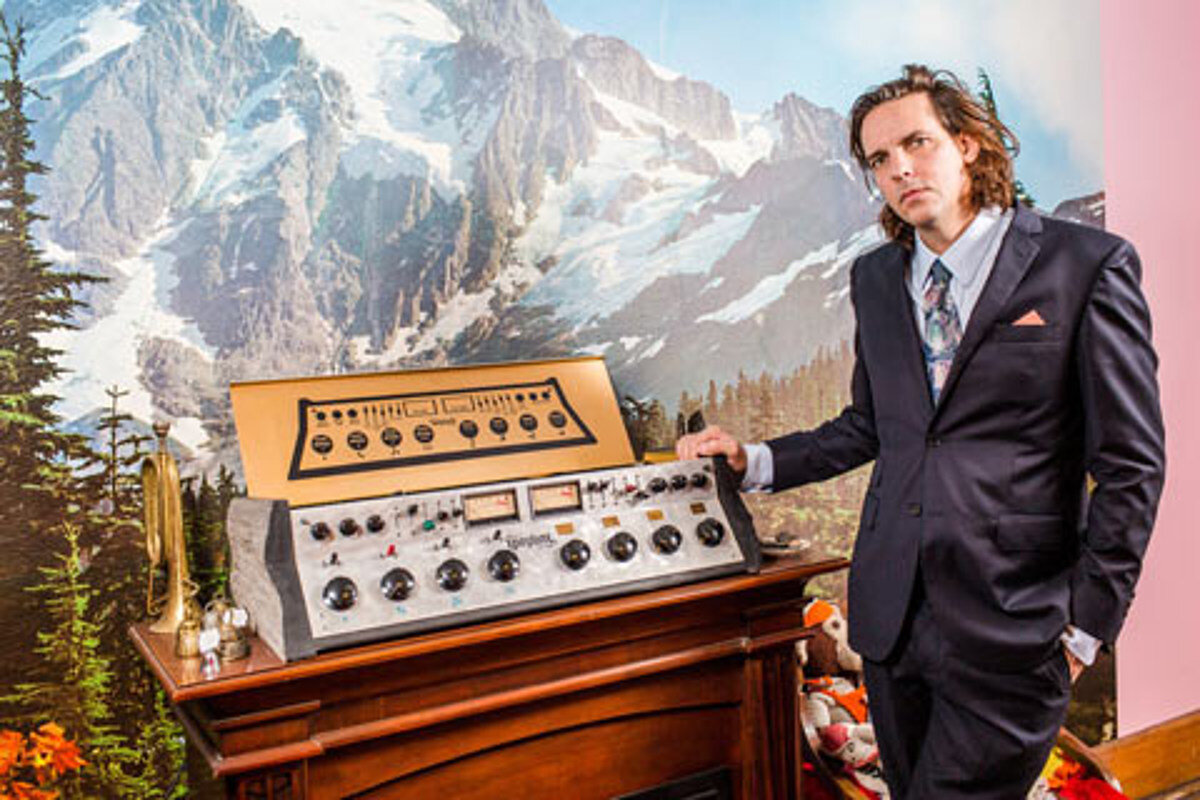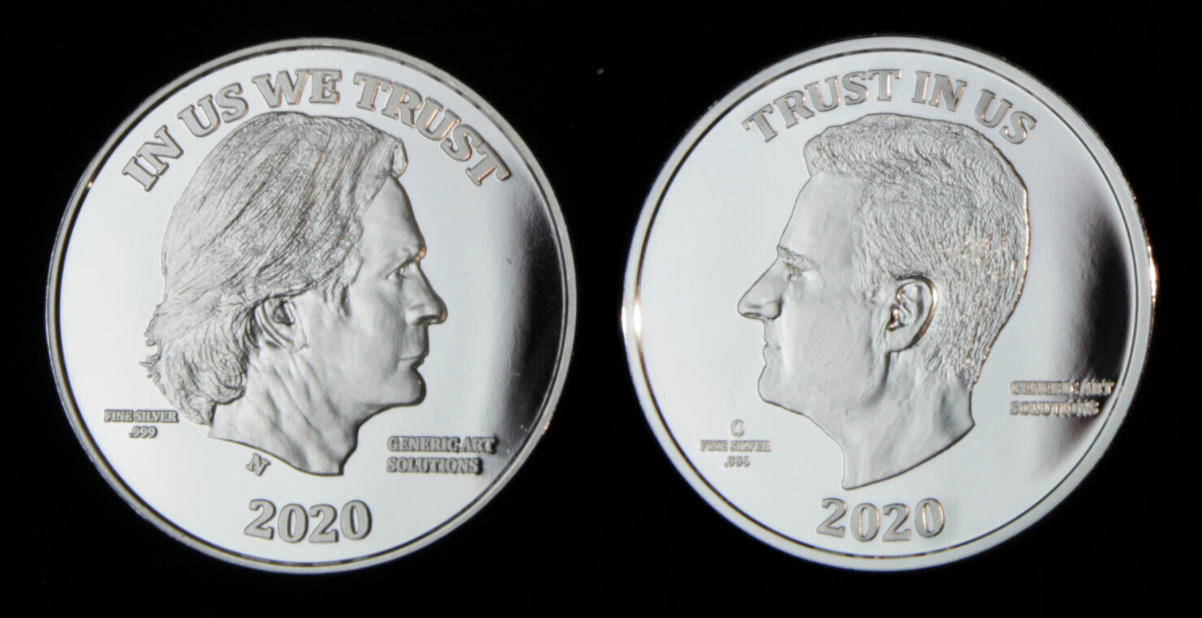Quintron's Weather Warlock Turned Hurricane Ida into Music

Quintron with his Weather Warlock
The new EP “People = Ants” presents the August hurricane as he experienced it on St. Claude Avenue.
Early in the afternoon of August 30, WeatherForTheBlind.org hummed with a low-grade menace. The website streams the music created by Quintron’s Weather Warlock—the first weather-activated synthesizer—but its drone had yet to reflect the fury of Hurricane Ida, although the storm had already made landfall. The streamed music droned on in a way that bordered on peaceful, but the instrument couldn’t help but process the wind, rain, and temperature as music with a dangerous edge.
Quintron streamed the Weather Warlock until he lost power on St. Claude Avenue for good somewhere around 8 p.m., and starting around 4 p.m., he began to record the output. He recorded major weather events in the year or so after inventing The Weather Warlock, but at some point the newness wore off and he recorded it less frequently. “It didn’t occur to me to record this hurricane until I saw what it was, then I scrambled to set up the recording,” he says.
The Weather Warlock is an unusual instrument in that it will generate sound if it’s on because there’s always weather, but Quintron can take a more active role in shaping the sound by tweaking knobs and dials. During Hurricane Zeta last year, he played the Weather Wizard and treated the experience as a kind of live performance, even including his voice in the live stream at times. During Ida though, he avoided inserting himself into the process “because it was so nuts,” Quintron explains. “I wanted a true capturing of what the weather was doing.”
Recently, Quintron released People=Ants (Hurricane Ida Recordings) on Bandcamp, and one of its two tracks comes from those Hurricane Ida recordings. Although WeatherForTheBlind.com streamed the music relatively untouched, he played a more active role when he created the track for the EP. Quintron took four or so sections all recorded in the same hour to create the title track, layering and panning parts to create a more ominous, fearsome sound.
“The music I released is definitely a crafted representation of what it felt like,” he says.
The Weather Warlock itself is a Quintron product in so many ways. He has always brought a working class practicality to experimental ideas, and his signature Drum Buddy light-activated rhythm synthesizer uses coffee cans with holes punched in them to determine a rhythm pattern. He has modified the organs he plays, and even though the idea of a weather-activated synth sounds farfetched, he approached its creation with a similar sensibility. He made it in part using PVC pipe, not for aesthetic reasons but because it will hold up.
“It’s all plumbing stuff because it weathers really well,” he explains. But the materials shape the sound in the same way that metal and wood affect the sound of horns and stringed instruments. The PVC contributes a clearly recognizable, almost tactile texture to the sound, regardless of the triggering input. “It’s a hollow, flange-y sound,” Quintron says.
Quintron invented the prototype Weather Warlock with the time and money at his disposal when he received a Robert Rauschenberg Fellowship in 2014, but that experience was just one of his interactions with the fine art world. In 2010, he and his musical, professional and life partner Miss Pussycat had a show at the New Orleans Museum of Art that featured her puppets and him, installed in a display space with his instruments, recording equipment, and a time clock that he punched into each day when he worked on their album Sucre du Sauvage. The second track on the EP, “Tone Poem for St. Claude Avenue,” was commissioned by the Crystal Bridges Museum of American Art in Bentonville, Arkansas, and he made it from sounds he found nearby. It, like so much of Quintron and Miss Pussycat’s work, makes their neighborhood central to the art.
“Living on St. Claude is like living on a river,” Quintron says. “Everything passes through there, and it’s always changing. I know my neighbors, but it’s not like a small, quiet neighborhood where you know your neighbors by name and they’re all you see all day. There’s every kind of everything walking past our house all the time. It’s exciting. I don’t think I could not live on a big street after this. For most of my adult life, I’ve lived on a big, highway-like street like this, and there’s something very soothing and exciting about it.”
Quintron’s career can seem like an extended exercise in performance art, but he approaches impractical ideas with such practicality that he breaks down any distance the concept might engender. He comes from the DIY world of rock ’n’ roll, so he also understands the need to pay off an idea with some kind of personal connection. On People=Ants, that manifests in the sounds of emergency vehicles on St. Claude Avenue, signaling a genuine emergency instead of the more abstract, conceptual one listeners might hear in the music.
That found audio came courtesy of the newest addition to the Weather Warlock—The Traffic Sax.
“It’s a fully weatherproofed condenser mic in a long tube that’s cut to tune the resonance to the key that the Weather Warlock is in, and it’s shaped like a saxophone,” Quintron explains. He installed one in front of their house, and the crashing sound it captures is dumpsters being blown around and garbage cans blowing down the street.
“I favored that in these recordings because I knew that that was the special part that I’d be unable to recreate.”
The Traffic Sax presents the kind of challenge that only an artist like Quintron would face. On July 4, he installed and performed with the newest, most sophisticated version of the Weather Warlock at the Ohr-O’Keefe Museum of Art in Biloxi, and it included a Traffic Sax. He discovered that he made it too accessible because kids found it, they began shouting into it. He had to move it, and that experience has made him cagey about where he installed the one on St. Claude so that kids don’t hijack that one too. But although it’s frustrating, he understands that impulse.
“You would too if you were an angry eight-year-old,” he says.
Quintron and Miss Pussycat stayed through Hurricane Ida and were glad they did. Their roof leaked in every room, but they were able to put down Tupperware tubs to catch the rain. The sideways rain blew under the tarpaper under his shingles and soaked the plaster ceiling until it finally was too heavy to remain in place. “It caved in the ceiling in three rooms,” he says. A tree also fell on the back of their house, and dealing with all of that left Quintron too stressed out to navigate his way through the FEMA bureaucracy to get help. He has started the process, but instead of waiting for governmental magic to happen, he has dedicated the proceeds from sales of People=Ants to repairing his roof.
As bad as the damage they took during Hurricane Ida sounds, it doesn’t compare to what they experienced after Hurricane Katrina when the Spellcaster Lounge took on four feet of water.“That was way worse because it was disgusting Industrial Canal water in the house in the basement for however-many days,” Quintron says. That soaked the sheetrock so the basement had to be gutted and rebuilt.
They did not lose any musical equipment or art supplies during Ida, which for Quintron was part of the point.
“That’s why you stay, to mitigate the damage as it’s happening,” he says. They caught the water to keep it from leaking through the floor and moved gear out of harm’s way. That prevented additional damage, but the experience was exhausting. “I’m glad we were there, but the person I’m married to vows to never stay for another hurricane,” he says.
After two days of dealing with the heat, lack of electricity, and growing danger on St. Claude, Quinton and Miss Pussycat left New Orleans and moved into the Ohr-O’Keefe Museum, designed by famed architect Frank Gehry. “We stayed in one of those pods next to where my piece was,” Quintron says. “It was nuts up there. It was full of New Orleans people buying up all the gas and the gas cans.” The museum was not, however, full of art. His Weather Warlock and the pottery in the collection were too fragile to reliably survive a good shaking and had been moved to safety.
“We were sleeping there with our cat and a litter box in a million-dollar George Ohr, Frank Gehry pod,” he says.
They were still living in the museum when the art returned, so Quintron could reinstall that Weather Warlock, which he considers the most complex and expressive model yet.
“I wish I’d had it on St. Claude during Ida,” he says
For more on the Weather Warlock, see the piece I wrote for the New Orleans Advocate in 2014.
Creator of My Spilt Milk and its spin-off Christmas music website and podcast, TwelveSongsOfChristmas.com.






